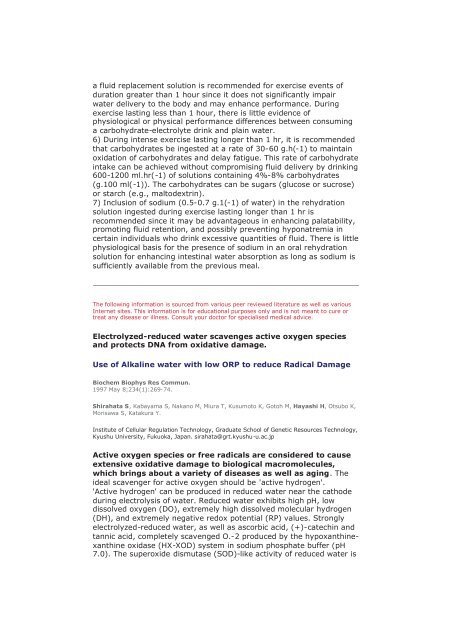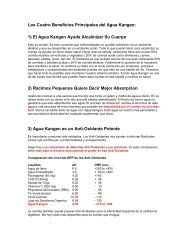ACID-ALKALINE BALANCE: ROLE IN CHRONIC ... - My Kangen Tools
ACID-ALKALINE BALANCE: ROLE IN CHRONIC ... - My Kangen Tools
ACID-ALKALINE BALANCE: ROLE IN CHRONIC ... - My Kangen Tools
You also want an ePaper? Increase the reach of your titles
YUMPU automatically turns print PDFs into web optimized ePapers that Google loves.
a fluid replacement solution is recommended for exercise events of<br />
duration greater than 1 hour since it does not significantly impair<br />
water delivery to the body and may enhance performance. During<br />
exercise lasting less than 1 hour, there is little evidence of<br />
physiological or physical performance differences between consuming<br />
a carbohydrate-electrolyte drink and plain water.<br />
6) During intense exercise lasting longer than 1 hr, it is recommended<br />
that carbohydrates be ingested at a rate of 30-60 g.h(-1) to maintain<br />
oxidation of carbohydrates and delay fatigue. This rate of carbohydrate<br />
intake can be achieved without compromising fluid delivery by drinking<br />
600-1200 ml.hr(-1) of solutions containing 4%-8% carbohydrates<br />
(g.100 ml(-1)). The carbohydrates can be sugars (glucose or sucrose)<br />
or starch (e.g., maltodextrin).<br />
7) Inclusion of sodium (0.5-0.7 g.1(-1) of water) in the rehydration<br />
solution ingested during exercise lasting longer than 1 hr is<br />
recommended since it may be advantageous in enhancing palatability,<br />
promoting fluid retention, and possibly preventing hyponatremia in<br />
certain individuals who drink excessive quantities of fluid. There is little<br />
physiological basis for the presence of sodium in an oral rehydration<br />
solution for enhancing intestinal water absorption as long as sodium is<br />
sufficiently available from the previous meal.<br />
The following information is sourced from various peer reviewed literature as well as various<br />
Internet sites. This information is for educational purposes only and is not meant to cure or<br />
treat any disease or illness. Consult your doctor for specialised medical advice.<br />
Electrolyzed-reduced water scavenges active oxygen species<br />
and protects DNA from oxidative damage.<br />
Use of Alkaline water with low ORP to reduce Radical Damage<br />
Biochem Biophys Res Commun.<br />
1997 May 8;234(1):269-74.<br />
Shirahata S, Kabayama S, Nakano M, Miura T, Kusumoto K, Gotoh M, Hayashi H, Otsubo K,<br />
Morisawa S, Katakura Y.<br />
Institute of Cellular Regulation Technology, Graduate School of Genetic Resources Technology,<br />
Kyushu University, Fukuoka, Japan. sirahata@grt.kyushu-u.ac.jp<br />
Active oxygen species or free radicals are considered to cause<br />
extensive oxidative damage to biological macromolecules,<br />
which brings about a variety of diseases as well as aging. The<br />
ideal scavenger for active oxygen should be 'active hydrogen'.<br />
'Active hydrogen' can be produced in reduced water near the cathode<br />
during electrolysis of water. Reduced water exhibits high pH, low<br />
dissolved oxygen (DO), extremely high dissolved molecular hydrogen<br />
(DH), and extremely negative redox potential (RP) values. Strongly<br />
electrolyzed-reduced water, as well as ascorbic acid, (+)-catechin and<br />
tannic acid, completely scavenged O.-2 produced by the hypoxanthinexanthine<br />
oxidase (HX-XOD) system in sodium phosphate buffer (pH<br />
7.0). The superoxide dismutase (SOD)-like activity of reduced water is



